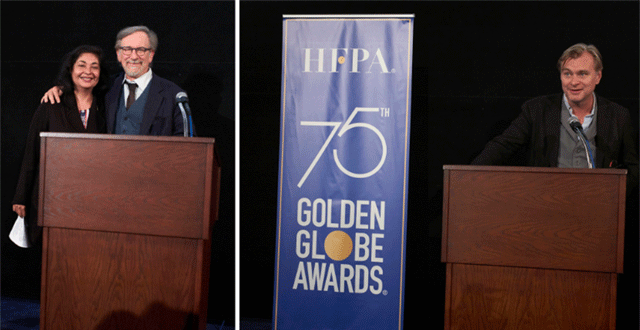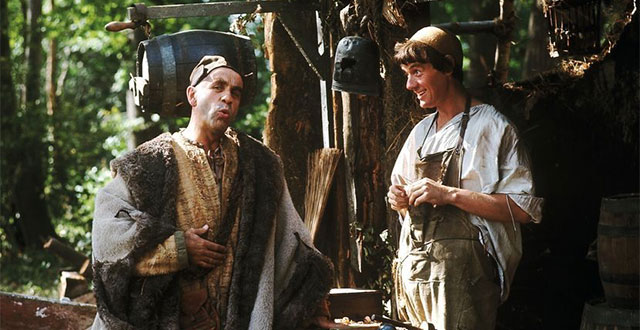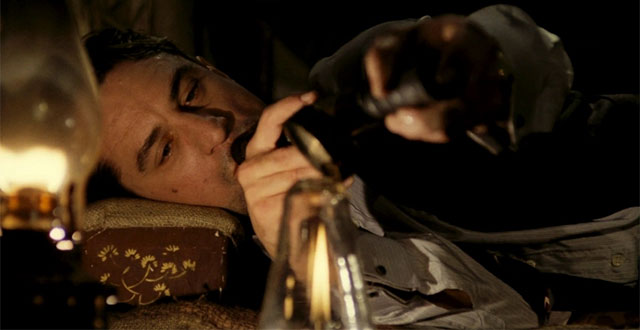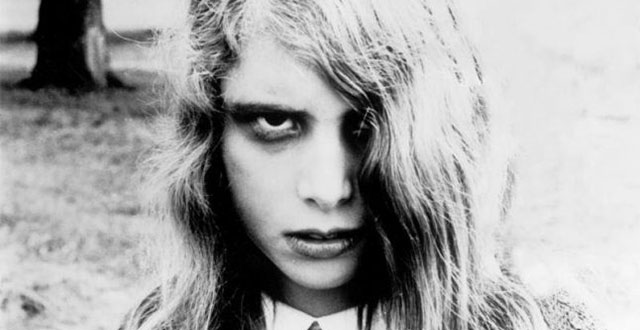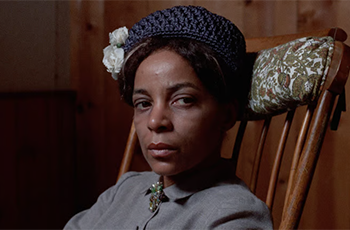News
Steven Spielberg and Christopher Nolan Join the HFPA for Restored Classic Films Screening
STEVEN SPIELBERG AND CHRISTOPHER NOLAN JOINED THE HOLLYWOOD FOREIGN PRESS ASSOCIATION, THE FILM FOUNDATION AND THE AMERICAN CINEMATHEQUE TO CELEBRATE THE 75TH ANNIVERSARY OF THE GOLDEN GLOBE® AWARDS WITH RESTORED CLASSIC FILMS SCREENING SERIES AT THE EGYPTIAN THEATRE
HOLLYWOOD, Calif. (Sept. 25, 2017) – Iconic filmmakers Steven Spielberg and Christopher Nolan joined the Hollywood Foreign Press Association (HFPA), The Film Foundation and the American Cinematheque for a special program to celebrate the 75th Anniversary of the Golden Globe® Awards. The restored films screening series took place Sept. 21-24 at The Egyptian Theatre in Hollywood, Calif. The restorations have been made possible in part by grants awarded annually to The Film Foundation by the HFPA. To date, the HFPA, in partnership with The Film Foundation, has helped fund the restoration of over 90 classic feature films.
HFPA President Meher Tatna expressed the importance film restoration has to the association, and committed continued support. “Film restoration is part of the HFPA's mandate, so that classic cinema, a part of Hollywood history, is preserved in its original glory and lives on for future generations to enjoy. We pledge to continue our support as long as we are around, at least for the next 75 years.”
“This diverse group of restorations makes it clear that the HFPA has a deep commitment to preserving the art of cinema. The Film Foundation and the HFPA have had a long and successful partnership, and we look forward to continuing our collaboration,” said Steven Spielberg, a founding board member of The Film Foundation.
“When you’re looking for the importance of film history, when you’re looking for the connections that are made between one generation of filmmakers and the next, they’re not always obvious,” said Christopher Nolan, board member of The Film Foundation. “They’re not necessarily the story or the characters of the script, or even the themes. That can only be experienced and passed on from generation to generation by preserving and restoring the experience of watching film.”
The restored classic films screened throughout the weekend included Elia Kazan’s A Face In The Crowd, the Powell-Pressburger masterpiece, The Red Shoes, Robert Altman’s Come Back To The Five And Dime, Jimmy Dean, Jimmy Dean, the first film version of Death Of A Salesman, and Indian director Satyajit Ray’s acclaimed Apu Trilogy.
Tune in to the 75th Annual Golden Globe Awards ceremony, airing on NBC live coast-to-coast on Sunday, January 7, 2018 from 5:00-8:00p.m./PST (8:00-11:00p.m./et).
ABOUT THE HOLLYWOOD FOREIGN PRESS ASSOCIATION
Founded in the 1940s during World War II, the HFPA was originally comprised of a handful of L.A.-based overseas journalists who sought to bridge the international community with Hollywood, and to provide distraction from the hardships of war through film. Seventy years later, members of the HFPA represent 56 countries with a combined readership of 250 million in some of the world’s most respected publications. Each year, the organization holds the third most watched awards show on television, the Golden Globe® Awards, which has enabled the organization to donate nearly $30 million to entertainment-related charities, scholarship programs and humanitarian efforts. For more information, please visit www.GoldenGlobes.com and follow us on Twitter (@GoldenGlobes) and Facebook (www.facebook.com/GoldenGlobes).
ABOUT THE FILM FOUNDATION
Created in 1990 by Martin Scorsese, The Film Foundation (TFF) is dedicated to protecting and preserving motion picture history. By working in partnership with archives and studios, the foundation has helped to restore over 750 films, which are made accessible to the public through programming at festivals, museums, and educational institutions around the world. TFF’s World Cinema Project has restored 31 films from 21 different countries representing the rich diversity of world cinema. The foundation’s free educational curriculum, The Story of Movies, teaches young people - over 10 million to date - about film language and history. For more information visit: www.film-foundation.org.
ABOUT THE AMERICAN CINEMATHEQUE
Established in 1981, the American Cinematheque is a 501 C 3 non-profit viewer-supported film exhibition and cultural organization dedicated to the celebration of the Moving Picture in all of its forms. At the Egyptian Theatre, the Cinematheque presents daily film and video programming which ranges from the classics of American and international cinema to new independent films and digital work. Exhibition of rare works, special and rare prints, etc., combined with fascinating post-screening discussions with the filmmakers who created the work, are a Cinematheque tradition that keep audiences coming back for once-in-a-lifetime cinema experiences. The American Cinematheque renovated and reopened (on Dec. 4, 1998) the historic 1922 Hollywood Egyptian Theatre. This includes a state-of-the-art 616-seat theatre housed within Sid Grauman's first grand movie palace on Hollywood Boulevard. The exotic courtyard is fully restored to its 1922 grandeur. The Egyptian was the home of the very first Hollywood movie premiere in 1922. In January 2005, the American Cinematheque expanded its programming to the 1940 Aero Theatre on Montana Avenue in Santa Monica. Major funding comes from the American Cinematheque’s Award Show. This year the organization honors Amy Adams on November 10.
The 61st BFI LONDON FILM FESTIVAL In Partnership With AMERICAN EXPRESS® Announces Full 2017 Programme
The 61st BFI London Film Festival in partnership with American Express® today announces its full programme, featuring a diverse selection of 242 feature films from both established and emerging talent. This 12 day celebration of cinema illustrates the richness of international filmmaking, with films to delight and entertain audiences, and also films that probe and interrogate issues of significance.
The Festival is the UK’s leading and most prestigious film festival, representing one of the first opportunities for audiences – both the UK public and film industry professionals - to see the very best new films from across the globe, alongside an events programme with some of the world’s most inspiring creative talents. This year, the Festival will host 28 World Premieres, 9 International Premieres and 34 European Premieres and will welcome a stellar line up of cast and crew for many of the films.
The 242 feature programmes screening at the Festival include: 46 documentaries, 6 animations, 14 archive restorations and 16 artists’ moving image features. The programme also includes 128 short films, and 67 countries are represented across short film and features.
Each evening of the Festival sees a Headline Gala presentation at Odeon Leicester Square. Films in Official Competition and Strand Galas are once again presented at the 820-seat Embankment Garden Cinema following a successful inaugural year in 2016, with audiences and filmmakers alike praising its quality of cinema experience. This temporary venue, constructed to the highest technical specifications, brings the festival to even more people and connects screenings in the West End with the BFI’s home cinema at BFI Southbank.
Alongside the Galas, Special Presentations and films in Competitions, the Festival will show a thrilling range of new cinema in sections Love, Debate, Laugh, Dare, Thrill, Cult, Journey, Experimenta and Family – which provide pathways for audiences to navigate the programme. In 2017, the LFF presents a new strand, Create, featuring films that celebrate artistic practice in all its channels and forms the electricity of the creative process, reflecting London’s position as one of the world’s leading creative cities.
Audiences have the opportunity to hear some of the world’s creative leaders through the Festival’s acclaimed talks’ series LFF Connects, which features artists working at the intersection of film and other creative industries, and Screen Talks, a series of in-depth interviews with leaders in contemporary cinema. Participants this year include Julian Rosefeldt & Cate Blanchett, David Fincher, Demis Hassabis, Nitin Sawhney, Johan Knattrup Jensen, Ian McEwan and Takashi Miike.
As one of the few film festivals in the world to be staged in a production capital, the Festival takes its place as a jewel in the crown of London’s cultural calendar, channelling the excellence of one of the world’s most vibrant cultural cities, and highlighting the enormous wealth of talent working in film today, both behind and in front of the camera. Alongside the industry programme and Awards, the Festival proudly acts as a launch pad for new as well as established voices, and supports filmmakers throughout their career aiming to interrogate how film and filmmaking reflects – and reflects on – our society.
The BFI London Film Festival each year provides a vibrant forum for the exchange of ideas, with films stimulating debate and shining a light on pressing social and political issues. This year a number of ‘talking points’ ripple through the Festival programme, including:
• LBGT – In the year of the 50th anniversary of the partial decriminalisation of homosexuality in England and Wales, the Festival presents a powerful LGBT line-up.
• Immigration and Social Division – Two of the defining themes of our times are explored by filmmakers who are committed to telling powerful and complex stories about borders – both real and psychological.
• Black Star – Following the BFI’s landmark season celebrating the range, versatility and power of black actors in film, recent world events give new urgency to questions of opportunity, and basic human rights.
• Visionaries – Cinema remains one of the most exhilaratingly kinetic and visually potent storytelling forms, and many filmmakers this year impress with the singularity and power of their vision, with keen imagination and dazzling style.
• Thrill – It’s a very strong year for global thrill seekers at the Festival, with a particularly strong showing from East Asia, which comes as the BFI embarks on the UK-wide season BFI Thriller, exploring how the genre reflects societal upheavals, fears and anxieties.
• Strong Women – The Festival continues to shine a light on strong women behind and in front of the camera. At this year’s Festival, 61 women directors are represented in the feature film selection, approximately 25% of the programme.
• Deafness and disability – Both feature with marked prominence in this year’s Festival programme, though the film industry still has a long way to go in terms of representation for disabled people. The Festival’s industry programme will include a partnership event on equality of opportunity and expression for deaf and disabled people working in film & television.
The Festival takes over screens at fifteen venues across the capital, from the West End cinemas – Vue Leicester Square and the iconic Odeon Leicester Square; central London venues – BFI Southbank, BFI IMAX, Picturehouse Central, the ICA, Curzon Mayfair, Curzon Soho, Empire Haymarket, Prince Charles Cinema and Ciné Lumière; and local cinemas – Hackney Picturehouse , Rich Mix in Shoreditch and Curzon Chelsea. Special screenings will also be held at the National Gallery and the Barbican, and several key events will also be cinecasted to cinema venues around the UK.
“It is a delight to welcome some of the most thrilling storytellers from across the world to the Festival – we love to watch and engage with the extraordinary conversations that the Festival brings to our doorstep with every edition,” comments Amanda Nevill, Chief Executive, BFI. “London has a big heart and this year we are again reminded of the generosity and freedom of this awesome capital city of ours which so readily embraces this multiplicity of cultures and new voices. This creativity is reflected across the UK and the engine that is enabling filmmaking to thrive, supported by a favourable fiscal environment, outstanding skills and talent and ever expanding infrastructure and facilities.”
“In these globally tumultuous times, filmmakers around the world have increasingly urgent stories to tell and more reasons than ever to reimagine our reality,” comments Clare Stewart, Festival Director. “This year’s BFI London Film Festival programme is rich with opportunity – to stay informed, be challenged, feel the pleasure of escape and see the world differently.”
Whether it’s short films or documentaries, live action or animation, audiences should find a film to suit their passions - and with a range of ticket options, including family ticket prices and £5 rush tickets for under-25s, the Festival will bring the vibrancy of the world’s film industry to as many people as possible, offering an unparalleled experience to see the films that everyone will be talking for months.
GALAS
OPENING & CLOSING NIGHT GALAS
As previously announced, the Festival opens with the European Premiere of BREATHE, the directorial debut of Andy Serkis, on Wednesday 4 October. Adventurous and charismatic, Robin Cavendish (Andrew Garfield) has his whole life ahead of him when he is paralysed by polio whilst in Africa and given just months to live. Against all advice, Robin’s wife Diana (Claire Foy) brings him home from hospital where her devotion and witty determination inspire him to lead along and fulfilled life. Together they refuse to be limited by expectations, dazzling others with their humour, courage and lust for life. A live cinecast brings all of the excitement from Leicester Square to simultaneous screenings taking place at cinemas across the UK.
Forget It, Jake, It’s Metrograph’s ‘Imagining Chinatown’ Series
Daniel Maurer
After paying tribute to Fire Island, Metrograph is looking a little closer to home with its newly announced series, “Imagining Chinatown.” The series, opening Sept. 27, aims to show how Hollywood has depicted Chinatown as a “hyperbolic fantasy space,” where one “partakes in copious amounts of opium” and “crime and sin are believed to go unpunished,” per a press release.
Needless to say, Roman Polanski’s Los Angeles-set Chinatown is in the mix, as is Chinatown Nights and San Francisco-set Big Trouble in Little Chinatown. If you missed Gremlins when Anthology reunited the film’s cast or when Alamo Drafthouse busted out the Stripe tiki mugs, well then you can see that Chinatown classic as well– just steps away from where Hanksy orchestrated his “No Mogwai Sold Here” prank.
There are some less expected picks as well: Woody Allen shot part of Cafe Society in Chinatown, but it’s Alice that gets play here, since the titular character visits a Chinese herbalist. Other New York-set films include Gangs of New York and The Bowery, a 1933 film set in the Gay Nineties that Metrograph assures us “has something to offend end literally everyone.”
Here’s a look at the full lineup.
The international Chinatown, accessed through red lacquered gates bearing formidable dragon motifs, has been a vital aspect of both history and myth- making in the West for over 200 years and counting. At once a place of yearning for the far-flung homelands of an ever-growing pan-Asian population abroad and a locale onto which the West’s collective fantasy of the Orient can be projected, the exotic exteriors and supposedly mysterious, vice-ridden corridors of Chinatown have never failed to stir the imagination of Hollywood. Chinatown has been rendered as a hyperbolic fantasy space where anything—even Mogwais— can be bought and sold; where one partakes in copious amounts of opium from what a Broken Blossoms intertitle calls “the lily-tipped pipe”; where crime and sin are believed to go unpunished because the locals play by their own rules and “Forget it, Jake—it’s Chinatown.” While far too often trafficking in insidious stereotypes, these were among the first films to create roles—albeit caricatured ones—for pioneering Chinese-American actors (when not featuring white actors). Metrograph pays tribute to the complex tradition of Chinatown on film, beginning Wednesday, September 27.
Alice (Woody Allen/1990/102 mins/35mm)
A lesser-known but wholly delightful entry from the heyday of Allen’s collaboration with the wizardly cinematographer Carlo di Palma, this magic realist spin on Alice in Wonderland stars Mia Farrow as a coddled Manhattan housewife whose tidy existence is upended when she begins to fantasize about handsome stranger Joe Mantegna. She seeks help from a Chinese herbalist, Dr. Yang (Keye Luke, Gremlins’ Mr. Wing and “Number One Son” to Warner Oland’s Charlie Chan), in Woody’s world a mystical version of an Upper West Side analyst.Big Trouble in Little China (John Carpenter/1986/99 mins/35mm)
Hop on the Jack Burton Pork-Chop Express! Long before Hollywood descended on Hong Kong to cannibalize its cinema, director Carpenter was attuned to the vibrations coming across the Pacific, as evidenced in his cult classic which has local boy Dennis Dun and honky buddy Kurt Russell penetrating the catacombs of San Francisco’s Chinatown to take on supernatural overlord Lo Pan. Shades of Sax Rohmer, but the joke is on Russell’s outsider, doing his best John Wayne impersonation and playing the archetypal all-American blowhard.The Bowery (Raoul Walsh/1933/92 mins/DCP)
Wallace Beery plays Chuck Connors, the legendary self-proclaimed “White Mayor of Chinatown,” here a slovenly unprincipled oaf whose prime preoccupation is getting the better of fellow showboat Steve Brodie (George Raft). Walsh was a true democrat who loved the feisty racial jibing of city life, and appropriately his rabble-rousing pre-Code imagining of New York in the Gay Nineties has something to offend end literally everyone.Broken Blossoms (D.W. Griffith/1919/90 mins/35mm)
Perhaps the most famous Chinese character in early American cinema was embodied by one Richard Barthelmess, cast against racial type as the lone friend of Lillian Gish’s poor wastrel, ceaselessly hounded by her bestial father in the slums of London’s Limehouse. Among Griffith’s best and most beautiful films, which finds the master of spectacle and sprawl forgetting his epic ambitions to work with rare delicacy and emotional intimacy.Chinatown (Roman Polanski/1974/130 mins/35mm)
“Chinatown” doesn’t play a major role in Polanski’s film of dirty dealing in 1930s Los Angeles, but it does a whole lot of metaphorical heavy lifting in the film’s famous kicker line, symbolic of a place where the rules and the language are beyond comprehension. We might mention that it’s a masterpiece, too, with Faye Dunaway as the woman in trouble, Jack Nicholson as nosey guy detective Jake Gittes, and John Huston as the vilest plutocrat in all of cinema.Chinatown Nights (William Wellman/1929/83 mins/35mm)
Four years before The Bowery, Wallace Beery played another uncouth variation on his “White Mayor of Chinatown,” here named Chuck Riley, in this pre-Code rabble-rouser (a/k/a Tong War) for hell-raising director “Wild Bill” Wellman. With the omnipresent Oland as the overboss of a sinister, opium smoke-wreathed Chinatown which tempts white rubberneckers like society gal Florence Vidor to come downtown, and a show-stopping shootout at a Chinese theatre.Gangs of New York (Martin Scorsese/2002/207 mins/35mm)
Fired by the spirits of Sam Fuller, Sergio Leone, and Walsh’s The Bowery, Scorsese drew from Herbert Asbery’s collection of underworld folklore to produce this rip-snorting epic of love and revenge in the time of the Draft Riots, with Daniel Day-Lewis as nativist Know-Nothing strongman Bill “The Butcher” Cutting and Leonardo DiCaprio as his sworn foe. For the shoot, Scorsese and production designer Dante Ferretti built their own Five Points at the Cinecittà studios in Rome, including a cavernous Chinatown club—this despite the fact that 1864 Manhattan lacked a large Chinese population.Gremlins (Joe Dante/1984/106 mins/35mm)
In American popular cinema, Chinatown has always been the place to go to find strange and exotic items, items such as—a pet mogwai? (That’s Cantonese for “monster,” by the way.) Joe Dante’s black-comic horror romp starts innocently enough, but when Gizmo’s new owners don’t heed the sage advice of Mr. Wing, there’s hell to pay for the residents of the little hamlet of Kingston Falls—and their Christmas decorations.Jade (William Friedkin/1995/95 mins/35mm)
A wild car chase through a Chinatown parade is the identifiable high-point of this sleazy-sexy little number courtesy Friedkin, who knows a thing or two about vehicular chaos, here contributing to the erotic thriller craze by way of a screenplay from subgenre godfather Joe Eszterhas. San Francisco detective David Caruso’s investigation of a millionaire’s murder puts him on the trail of a mysterious prostitute called “Jade,” who may or may not be lovely Linda Fiorentino, last to see the victim alive.Once Upon a Time in America (Sergio Leone/1984/229 mins/35mm)
Leone, known best for his sprawling Westerns, took on another distinctly American genre at the end of his career—the gangster picture. Moving back and forth along a timeline that spans from Prohibition to the late ‘60s, Leone’s rich, sad film, which manages to evoke both Proust and Fitzgerald, follows the character of Robert De Niro’s gangster Noodles from rags to riches and back again, as he considers his life from a palette in a Chinatown opium den—or is it all just a hop-head dream?
Restored by Cineteca di Bologna at L’Immagine Ritrovata Laboratory in association with Andrea Leone Films, The Film Foundation, and Regency Enterprises. Restoration funding provided by Gucci and The Film Foundation.Outside the Law (Tod Browning/1930/70 mins/35mm)
Browning, lover and discoverer of Anna May Wong, here auto-remakes a title he first touched in 1920, starring Edward G. Robinson (before his Little Caesar break) as Cobra Collins, an aristocrat of the underworld who sets his eyes on tableaux vivant model Mary Nolan, who can’t disguise her disgust when she learns that Cobra has a Chinese mother. After an opening full of patented Browning grotesquerie, Outside the Law settles into a surprisingly sweet story about the vicissitudes of domestic life.Year of the Dragon (Michael Cimino/1985/134 mins/35mm)
After years in the wilderness post-Heaven’s Gate, director Cimino came barreling back with this passionate policier, which finds Polish Greenpoint-raised cop Mickey Rourke pounding a new beat, trying to clean up a gang-ridden NYC Chinatown run by suave crime kingpin John Lone. Vigorously protested at the time of its release, it stands today as a showcase for Cimino’s rich, baroque style, a vintage neighborhood snapshot, and the only movie whose closing credits roll over curtain call film of Teresa Teng singing “Tian Mi Mi.”“Anna May Wong: Empress of Chinatown” Begins October 7
Born in Los Angeles’ Chinatown, Anna May Wong’s early days of working for her father’s laundry made her meticulous about dressing. Since her father wanted a boy, she watched her sister wear masculine clothes to appease him, and this would in time inspire her androgynous onscreen presence, a quality she shared with Marlene Dietrich, with whom she would be glamorously paired in Josef Von Sternberg’s Shanghai Express. Thanks to her preternatural beauty, Wong was modeling fur coats by the age of ten, and by the time she was a teenager she had broken into the movie business—not a time exceedingly receptive to screen testing Asian faces. Throughout her career Wong would bridle at the exoticized roles she was handed, even taking o for Europe when Hollywood disappointed her, but she approached every lm with incredible grace and dignity, and what remains of her through the years is a seductive, incredibly chic, and startlingly modern screen presence. Titles include Toll of the Sea (Chester M. Franklin), Old San Francisco (Alan Crosland), Daughter of the Dragon (Lloyd Corrigan), Shanghai Express (Josef von Sternberg), and Anna May Wong Visits Shanghai, a newsreel restored by UCLA, all in 35mm.
Night of the Living Dead 4K Restoration Opens in New York this October
Chris Alexander
New York’s Film Forum to screen Night of the Living Dead 4K restoration this October
Due to a copyright snafu with its distributor, George A. Romero‘s Night of the Living Dead lapsed into what was presumed to be the public domain, with every pirate alive then bootlegging and distributing poor quality versions of the film all over the world. Now, Janus Films will unleash NOTLD’s first-ever major restoration, opening on October 13 at New York’s Film Forum, followed by a national rollout. No more dump-bin, skid-row dupes of this groundbreaking 1968 classic ever again, thanks…
Shot outside of Pittsburgh at a fraction of the cost of a Hollywood feature by a band of filmmakers determined to make their mark, Romero’s masterpiece is one of the great stories of independent cinema: an ultra low-budget midnight hit turned box-office smash that became one of the most influential films of all time. A deceptively simple tale of a group of strangers trapped in a farmhouse who find themselves fending off a horde of flesh-eating ghouls newly arisen from their graves, Romero’s claustrophobic vision of a late-sixties America (literally) tearing itself apart rewrote the rules of the horror genre, combined gruesome gore with acute social commentary, and quietly broke ground by casting a black actor (Duane Jones) in the lead role. Now, you can finally see this immaculately-crafted film in glorious, monochrome shape, thanks to a new 4K restoration, scanned from the original camera negative and supervised by Romero himself. Stark, haunting, and more relevant than ever, Night of the Living Dead is back.
Night of the Living Dead was restored by The Museum of Modern Art and The Film Foundation. Funding was provided by the George Lucas Family Foundation and the Celeste Bartos Fund for Film Preservation. The restoration was overseen by George A. Romero and Image Ten — most especially, Gary Streiner, Russ Streiner, and John Russo — with restoration work done by Cineric Inc, NYC, and Audio Mechanics, Burbank, CA.
We can’t wait to see this film on the big screen in this sort of superlative shape. How about you?
